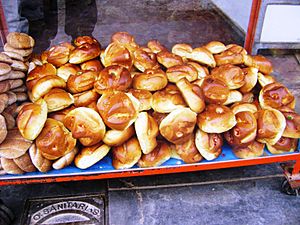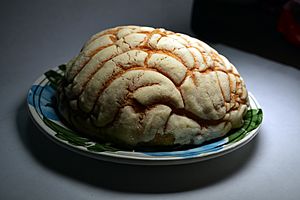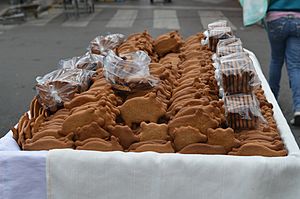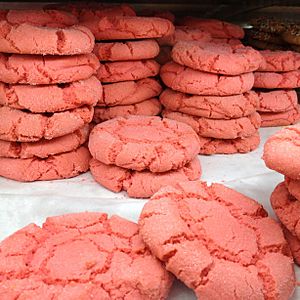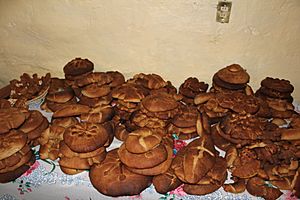Pan dulce facts for kids
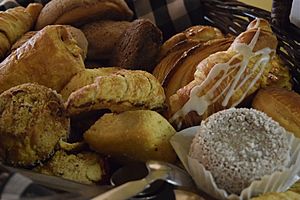
Pan dulce at a shop in Mexico City
|
|
| Type | Sweet bread |
|---|---|
| Place of origin | Mexico |
Pan dulce means "sweet bread" in Spanish. It is a general name for many different kinds of sweet pastries from Mexico. These tasty treats are very popular and are eaten every day for breakfast or a late supper called merienda.
The idea for pan dulce came from European people who moved to Mexico. They brought their own baked goods, like crispy rolls, baguettes, and sweet pastries. This inspired local bakers in Mexico to create their own unique sweet breads. Some famous types include besos, conchas, and cuernos.
Types of Pan Dulce
Mexican bakers are known for being very creative. It is believed that there are between 500 and 2,000 different kinds of sweet breads made in Mexico today! Many of these have fun and colorful names. Here are some of the most popular types:
Besos (Kisses)
A beso means "kiss" in Spanish. This sweet bread is round with a dome shape on top. It often has a small drop of jam in the middle, making it look like it's ready for a kiss!
Campechanas
Campechanas are thin, crispy, and flaky pastries. They are usually shaped like a rectangle or a circle. They have a shiny, caramel-colored glaze on top. These are very common and loved by many.
Conchas (Shells)
Conchas mean "shells" because they look like seashells. They have a special sugar topping that is scored to look like a shell pattern. This is one of the most famous Mexican pastries.
The dough for conchas is often flavored with vanilla or orange blossom. The topping can be chocolate, vanilla, pink, or other colors. Even though the classic shape is a shell, they can also be shaped like snails. Conchas are similar to Japanese melon pan. In other countries, they might be called "egg bread" or cemitas.
Cuernos (Horns)
Cuernos means "horns." These pastries are shaped like a horn, similar to the French croissant. They are a popular choice for a sweet breakfast.
Empanadas (Turnovers)
Empanadas are pastries that are folded over, like a turnover. They can be filled with many different things. In Mexico, they are often filled with sweet fruits like pumpkin or apple. Sometimes, they can also have savory fillings like meat or cheese.
Marianas
Marianas are small, soft vanilla sponge cakes. They are usually covered with raspberry jam and coconut on the outside. The top part of a Mariana often has icing or a fruit filling.
Marranitos / Cochinitos / Puerquitos (Little Pigs)
Marranitos, cochinitos, or puerquitos all mean "little pigs." These pastries are shaped like cute pigs. They are sweetened with piloncillo (a type of unrefined sugar) and spiced with cinnamon. People sometimes call them "gingerbread pigs" because they look similar, but they don't actually have ginger in them.
Orejas (Ears)
Orejas means "ears." These are flaky and sweet pastries that are shaped like an ear. They are very common in Mexican bakeries and are similar to a French Palmier pastry.
Piedras (Rocks or Stones)
Piedras means "rocks" or "stones." This pastry is made from old bread and is known for being quite hard, like a rock! Many people enjoy eating piedras by dipping them into very hot drinks.
Polvorones (Wedding Cookies)
Polvorones are a type of shortbread cookie. They are often eaten at weddings and other special celebrations. They are crumbly and sweet.
Yoyos (Yo-Yos)
Yoyos are Mexican pastries named after the toy. They are shaped just like a yo-yo, but without the string! They usually have a sweet filling, often raspberry jam, in the middle.
Special Breads for Holidays
Some types of pan dulce are made for specific holidays and traditions. These special breads have been part of Mexican culture for hundreds of years. Their stories often come from religious beliefs, especially the Roman Catholic faith.
Rosca de Reyes (Kings' Crown)
Rosca de reyes means "kings' crown." This sweet bread is a special treat eaten on Three Kings Day (Dia de los Reyes Magos). This day is celebrated on January 6th, twelve days after Christmas.
The round shape of the rosca de reyes represents the crowns of the Three Wise Men. A small plastic or ceramic figure of baby Jesus is baked inside the bread. Finding the hidden baby Jesus means you need to host a party on February 2nd for Dia de la Candelaria (Candlemas).
Pan de Muerto (Bread of the Dead)
Pan de muerto means "bread of the dead." This special bread is eaten and offered during the Día de Muertos (Day of the Dead) celebration in October and November. Day of the Dead is a lively and colorful holiday where families remember and honor their loved ones who have passed away.
The tradition of pan de muerto comes from an ancient Aztec custom. They would place food offerings on tombs to help spirits on their journey. Pan de muerto can be shaped in many ways, like skulls, animals, crosses, or mummies. The traditional shape is round, with a small ball on top to represent a skull. Four bone-like shapes are placed on top to symbolize the four directions of the universe.
Pan Dulce Around the World
Even though pan dulce has European roots, it is now considered a true Mexican food. Other countries in Latin America and even Europe have adopted some Mexican pastries. However, Mexico is where many new and creative shapes of pan dulce come from.
In Mexico
In Mexico, pan dulce is usually eaten for breakfast or as an evening snack. People often enjoy it with hot chocolate, warm milk, or coffee. They might even dip the bread into their drink for a better taste! Pan dulce has been an important part of Mexican food since the time when Spaniards brought wheat and the French brought their baking styles. It's also very affordable, which makes it a daily treat for many.
In the United States
Thanks to people moving from Mexico, pan dulce can now be found in many parts of the United States. You can find it in Mexican markets in states like California, Texas, Arizona, and New York. While it might not be eaten as often as in Mexico, it is a common and cherished food in many Latin American homes across the U.S.
See also
 In Spanish: Pan dulce para niños
In Spanish: Pan dulce para niños


